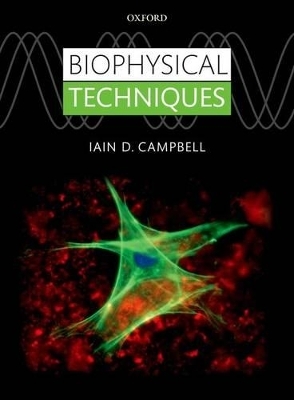
Biophysical Techniques
Seiten
2012
Oxford University Press (Verlag)
978-0-19-964214-4 (ISBN)
Oxford University Press (Verlag)
978-0-19-964214-4 (ISBN)
Biophysical Techniques explains in a readily-accessible way the basics of the various biophysical methods available so students can understand the principles behind the different methods used, and begin to appreciate which tools can be used to probe different biological questions, and the pros and cons of each.
Many current questions in biology are probed by using a range of biophysical methods, often in tandem. These increasingly powerful and sophisticated tools allow us to study the structure and dynamics of the complicated mixture of interacting molecules that make up the living cell.
Biophysical Techniques explains in a readily-accessible way the basics of the various methods available - including those used to study molecular structure, cell structure, and dynamic interactions - so that students can understand the principles behind the different methods used, and begin to appreciate which tools can be used to probe different biological questions, and the pros and cons of each.
Exploring the latest enhancements to classical techniques, and introducing computational techniques that have emerged relatively recently, the book provides a broad survey of the range of techniques now at the disposal of an investigator.
The biophysical techniques introduced can be explained in physical and mathematical terms; instead of assuming a detailed knowledge of physics or maths, however, the book uses a series of Tutorials and Boxes to provide essential background guidance on these topics, giving the reader extra support in fully understanding the subject. Learning and understanding is supported still further with thought-provoking end-of-chapter problems, and a range of online Journal Clubs, to illustrate to the reader how a range of biophysical techniques have been used in contemporary research.
In an age in which we are probing the working of biological systems in more detail, and with more refinement, than ever before, Biophysical Techniques is the ideal guide for any student who needs to understand the power of biophysical techniques in biological research.
Online Resource Centre
For students:
Journal Clubs for a number of chapters help the reader to explore how biophysical techniques are used in active research
For registered adopters of the text:
Figures from the book in electronic format
Many current questions in biology are probed by using a range of biophysical methods, often in tandem. These increasingly powerful and sophisticated tools allow us to study the structure and dynamics of the complicated mixture of interacting molecules that make up the living cell.
Biophysical Techniques explains in a readily-accessible way the basics of the various methods available - including those used to study molecular structure, cell structure, and dynamic interactions - so that students can understand the principles behind the different methods used, and begin to appreciate which tools can be used to probe different biological questions, and the pros and cons of each.
Exploring the latest enhancements to classical techniques, and introducing computational techniques that have emerged relatively recently, the book provides a broad survey of the range of techniques now at the disposal of an investigator.
The biophysical techniques introduced can be explained in physical and mathematical terms; instead of assuming a detailed knowledge of physics or maths, however, the book uses a series of Tutorials and Boxes to provide essential background guidance on these topics, giving the reader extra support in fully understanding the subject. Learning and understanding is supported still further with thought-provoking end-of-chapter problems, and a range of online Journal Clubs, to illustrate to the reader how a range of biophysical techniques have been used in contemporary research.
In an age in which we are probing the working of biological systems in more detail, and with more refinement, than ever before, Biophysical Techniques is the ideal guide for any student who needs to understand the power of biophysical techniques in biological research.
Online Resource Centre
For students:
Journal Clubs for a number of chapters help the reader to explore how biophysical techniques are used in active research
For registered adopters of the text:
Figures from the book in electronic format
Iain Campbell is a Professor of Structural Biology in the Department of Biochemistry at the University of Oxford, and Emeritus Research Fellow of St John's College, Oxford. A member of the Department of Biochemistry since 1976, Iain has a long-held interest in the use of physical tools to find out how the machinery of the cell operates.
1. Introduction ; 2. Molecular principles ; 3. Transport and heat ; 4. Scattering, refraction, and diffraction ; 5. Electronic and vibrational spectroscopy ; 6. Magnetic resonance ; 7. Microscopy and single molecule studies ; 8. Computational biology ; 9. Tutorials
| Zusatzinfo | 200 BW Line, 200 Colour Line |
|---|---|
| Verlagsort | Oxford |
| Sprache | englisch |
| Maße | 195 x 265 mm |
| Gewicht | 794 g |
| Themenwelt | Naturwissenschaften ► Biologie ► Biochemie |
| Naturwissenschaften ► Physik / Astronomie ► Angewandte Physik | |
| ISBN-10 | 0-19-964214-1 / 0199642141 |
| ISBN-13 | 978-0-19-964214-4 / 9780199642144 |
| Zustand | Neuware |
| Haben Sie eine Frage zum Produkt? |
Mehr entdecken
aus dem Bereich
aus dem Bereich


